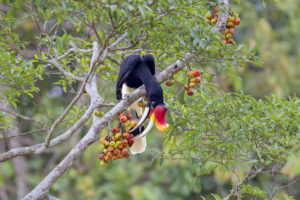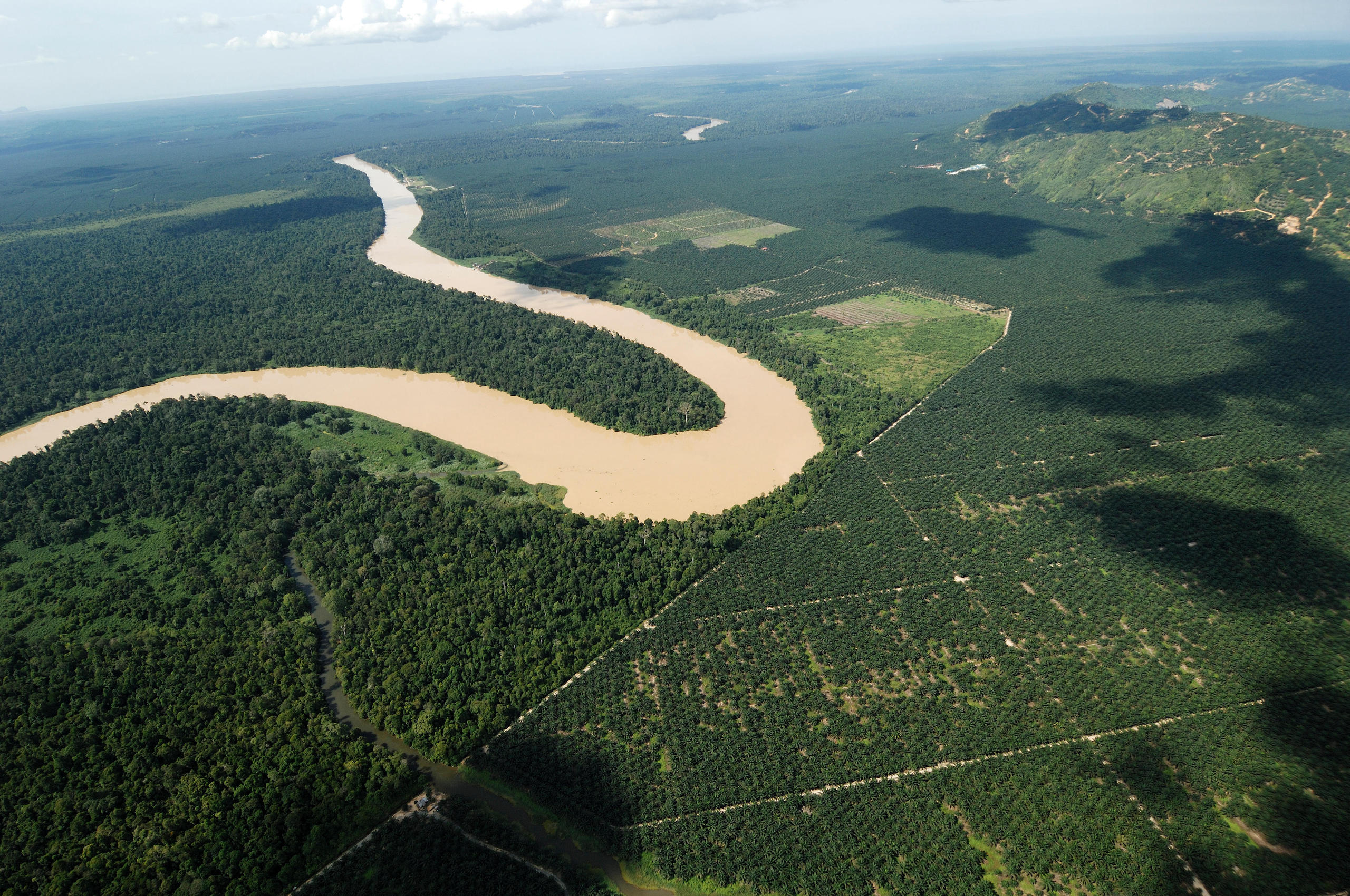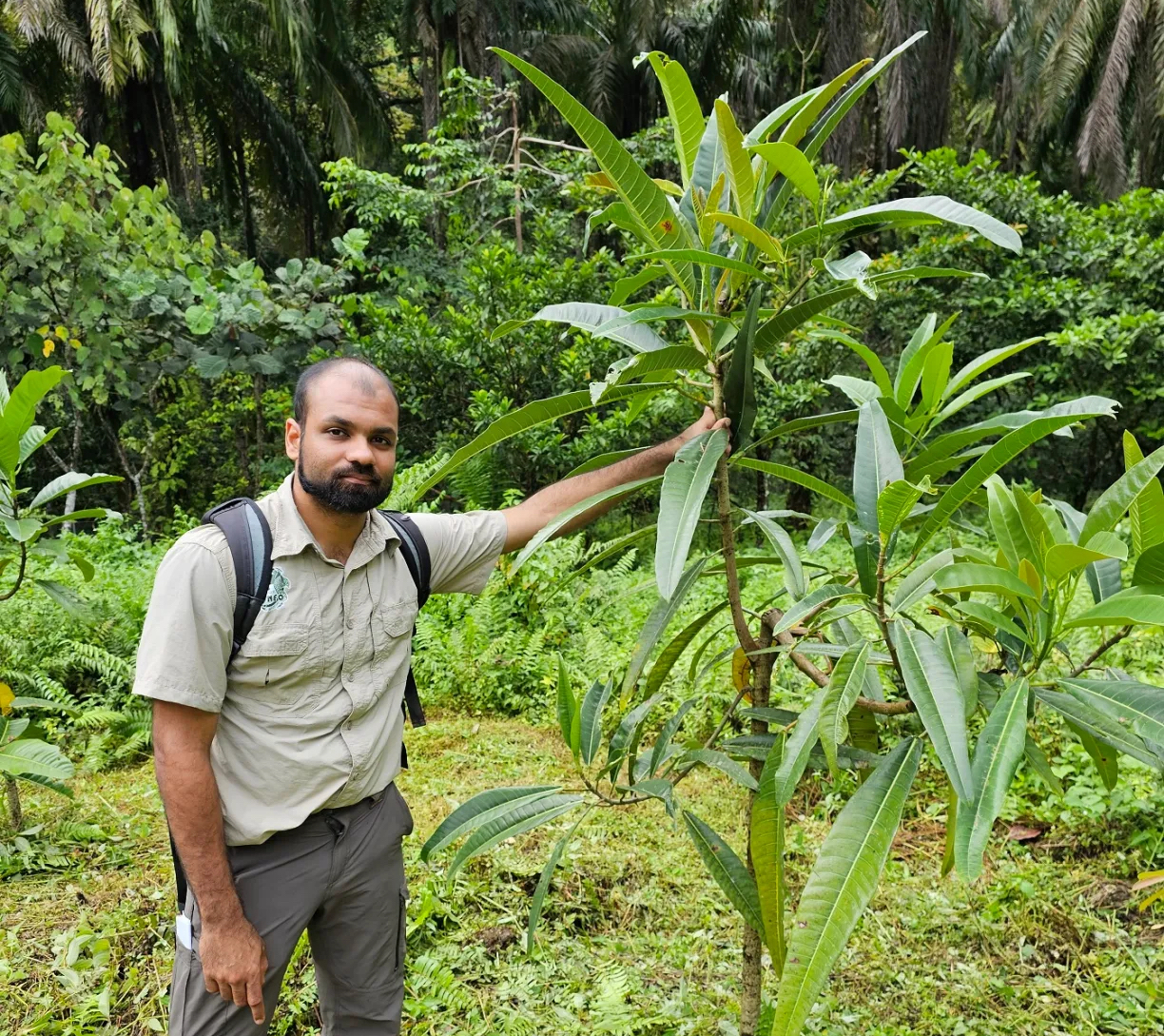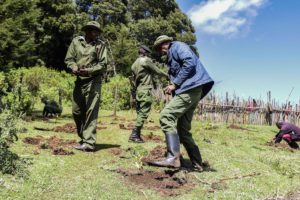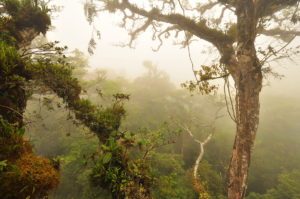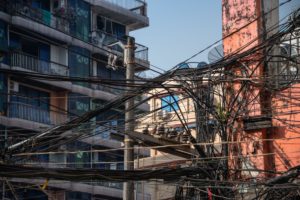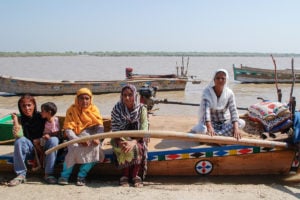For the past 12 years, Malaysian wildlife veterinarian Zainal Zainuddin has been quietly developing the world’s largest collection of living fig trees. Spread over three one-hectare sites in Sabah, northern Malaysian Borneo, it includes more than a thousand plants of 87 Ficus species. There are strangler figs, climbers – with figs bigger than tennis balls – and trees that produce figs on their trunks, or even on underground runners.
Zainal’s fig garden was initially meant to serve a species of rhinoceros that is now extinct in Malaysia. Today it has a new role, providing planting material for people trying to restore Sabah’s forests, develop sustainable wildlife tourism and show that endangered wildlife can coexist with the oil palm industry. This is all possible because fig trees are “keystone species”, endowed with ecological superpowers that allow them to have an outsized effect on their tropical forest ecosystems.
Feeding rhinos
Zainal moved to east Sabah from Peninsular Malaysia in 2010 to work for the NGO Borneo Rhino Alliance (Bora), caring for critically endangered Sumatran rhinoceroses at a rescue centre in the Tabin Wildlife Reserve. The rhinos needed 30kg of fresh leaves to eat each day and fig leaves were their favourites.
To maintain this food supply, Zainal began collecting and planting many of Borneo’s 160 wild fig species. He gathered seedlings from the forest floor, took cuttings from mature trees, and removed young strangler figs from old oil palms, where they had grown out of seeds dispersed in the faeces of passing animals. He became skilled at a technique called marcotting, which involves forcing a fig tree’s branch to produce roots so it can be removed and replanted elsewhere.
“Over time, my staff and I started collecting more species from around the reserve and outside, whenever we came across a new species,” says Zainal. “We even graded the fig species according to the preference of each rhino.”
But in November 2019, the last Sumatran rhino at the centre died. This female, called Iman, was the last known member of her species in all of Malaysia. It was a heartbreaking moment for Zainal, albeit one that has ironically enabled him to help other embattled species.
Rather than close down the organisation, Zainal and Bora’s director John Payne rebranded it as Bringing Back Our Rare Animals (retaining the Bora acronym). They began using the rhino’s food garden to mass-produce fig trees for forest restoration and to enrich wildlife habitats in oil palm plantations and logged forest reserves.
Why figs?
Payne had been working to conserve wildlife in Malaysia since the 1970s. He had watched as Sabah’s rainforests became heavily logged or replaced entirely by oil palm. Such plantations now cover more than a fifth of the state and, with only 8% of the original forest still intact, wildlife is feeling the squeeze. Amidst this threat, however, Payne and his counterparts at the conservation NGO Hutan had noticed something counterintuitive: orangutans were able to survive in small islands of forest in a sea of oil palms.
Payne concluded that fig trees growing on oil palms were keeping the apes supplied with food and enabling males to migrate across the landscape to breed. Fig species are disproportionately important sources of food for wildlife as ripe figs can be found year-round – they sustain wild animals when most other fruit is unavailable.
As well as feeding orangutans, figs are vital resources for monkeys and gibbons, nocturnal civets and fruit bats, and dozens of birds including hornbills. In fact, all fruit-eating animals in Borneo eat figs, and most of them then disperse the seeds, along with hundreds of other species’ seeds. Increasing the number of fig trees can therefore encourage natural forest restoration.
If you plant figs, you’ll automatically increase the amount of wildlifeQuentin Phillipps, Sabah-born naturalist
Payne first proposed the concept of planting figs to increase food for orangutans in 2007, while working as an advisor to the World Wide Fund for Nature (WWF) Malaysia. Back then he was in need of a fig supply, but once Iman the rhino died, Payne was able to resurrect his idea using the fig garden that had once fed her.
Over the past few years, Bora, Hutan and other organisations have been encouraging palm oil companies to plant and maintain fig trees in buffer zones where their plantations meet rivers or protected forest, and in areas unsuitable for oil palms.
They spread their message to the palm oil sector through meetings, articles in industry journals, partnerships and training events. They point out that this can help companies meet the certification criteria for national and international sustainability standards, while enabling orangutans and other wildlife to survive and migrate between patches of forest.
Long-term promises
The fig planters are guided by the knowledge of Quentin Phillipps, a Sabah-born naturalist who has spent years cataloguing Borneo’s fig species and their ecology. He spends much of his time trying to persuade managers of oil palm plantations, forestry lands and wildlife resorts to plant these trees.
“Figs are a very good source of food for wildlife,” Phillipps says. “So, if you plant figs, you’ll automatically increase the amount of wildlife in an area. The only problem is a fig tree takes about ten years to fruit, so we are really making long-term promises. If you plant a lot of fig trees now, in ten years, your project will have a lot more wildlife.”
Phillipps says the most important fig is a tree called the red river fig (Ficus racemosa), which grows along most of Borneo’s rivers and fruits several times a year: “On the Kinabatangan River, for instance, you’ve got Ficus racemosa about every 100 metres on both banks. It is the major source of food for wildlife in the area, including the fish and the things that eat them, like crocodiles, monitor lizards, herons and egrets. It also feeds primates, fruit bats and hornbills, so it is like a multi-purpose fig.”
Other key Ficus species include the strangler figs that grow on other trees and can produce as many as a million figs at the same time. Early efforts to plant these species were thwarted by foraging elephants and deer, but Sabah’s forestry department overcame this by planting them on wooden platforms or tree stumps.
“Like Bora and [other organisations], we have also been working on propagation of figs, and are introducing figs in several of our restoration projects,” says Robert Ong, deputy chief conservator of forests at Sabah’s forestry department.
Phillipps says that where oil palm is adjacent to forest, figs will naturally spread into the oil palm along the margins. “Leaving oil palms intact in buffer zones results in a natural increase in strangler fig numbers, as birds and mammals will disperse their seeds there,” he says. “Don’t cut the set-aside oil palm and in five to 10 years, you’ll have a forest of figs.”
Branching out
In 2020, the Sabah Forestry Department formally recognised Bora’s fig garden as the Sabah Ficus Germplasm Centre. In addition to its living fig trees, it now has a seed bank storing hundreds of thousands of seeds representing 45 Ficus species at -82C. The centre produces 1,000 seedlings and cuttings each month, offering them for free to the land managers it is engaging with, along with planting and maintenance assistance.
“We have restored nearly 14,000 fig plants now,” says Zainal. “For every plant that we restore, there is accountability; we check them every two months. If they are not doing well, we replace them. With the seed bank, we can propagate our seeds at any time.”
Zainal says it is important to combine different Ficus species as they produce their figs in different ways and attract different animals. “It is like a whole ecosystem of figs,” he says.
The palm oil industry overall has yet to support the ideaJohn Payne, director of Bringing Back Our Rare Animals
According to Payne, Bora is now experimentally planting figs in “set-aside” areas on the plantations of seven major oil palm growers. One of these projects is WWF Malaysia’s Unilever-funded Sabah Landscape Programme. The project involves WWF working with the state-owned oil palm company Sawit Kinabalu to connect two patches of forest: the Tabin Wildlife Reserve and the Silabukan Forest Reserve.
The key to scaling up, says Payne, is to get buy-in not only from interested individual estate managers, but also from company leaders. “To date, the palm oil industry overall, at national level, has yet to support the idea,” he says. “This in turn discourages individual plantation owners from restoring their set-aside areas.”
Phillipps is more upbeat. He says people are now planting fig trees or setting up fig nurseries in dozens of places across Sabah: “There’s been a change in awareness among people who plant trees, at all levels, that figs should be a component in any reforestation programme. The education is getting through, but it takes time. We have to keep pushing and pushing.”
Conservation tourism
One of Sabah’s most enthusiastic fig planters is Shavez Cheema. Born in Brunei, Cheema is the founder of 1StopBorneoWildlife, an organisation that uses proceeds from wildlife conservation tourism to fund tree planting and other activities.
Cheema has collaborated with the conglomerate Sime Darby to plant several hundred figs in an experimental garden on one of its oil palm plantation buffer zones. By scaling up planting, he wants this to become a fig tree corridor connecting south-east Sabah’s Tawau Hills Park protected area with Bukit Gemok, an isolated forest to its south. Before that though, Cheema must figure out how best to grow these plants. Working closely with Zainal at the Sabah Ficus Germplasm Centre, he hopes to “tell every other reforestation group on Borneo that ‘this is the way you do it’”.
Cheema is also excited by the potential of fig trees to boost wildlife tourism. Every week for the past four years, Cheema has monitored 50 mature strangler figs near the headquarters of Tawau Hills Park to predict when the next crop will ripen. He has also identified which fig species attract the most wildlife, from gibbons and monkeys to hornbills. Now Cheema and Phillipps are urging wildlife resorts to plant fig trees, which will provide tourists with better wildlife encounters.
“If these species are fruiting, you will see all sorts of animals,” says Cheema. “They come all day long. It is a phenomenal spectacle. I’ve mapped out the best figs, and I know when they fruit. Imagine a tourist wants to see a helmeted hornbill… well, I can tell you when and where to see them. This Ficus work is revolutionary – a game-changer for wildlife tourism and reforestation.”
